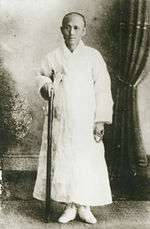Daejongism
| Daejongism | |
| Hangul | 대종교 |
|---|---|
| Hanja | 大倧敎 |
| Revised Romanization | Daejonggyo |
| McCune–Reischauer | Taejonggyo |

Daejongism (Korean: 대종교 Daejonggyo or Taejongkyo, "religion of the Divine Progenitor"[1] or "great ancestral religion"[2]:192) or Dangunism (Korean: 단군교 Dangungyo or Tangunkyo, "religion of Dangun")[3] is the name of a number of religious movements within the framework of Korean shamanism, focused on the worship of Dangun (or Tangun). There are around seventeen of these groups, the main one of which was founded in Seoul in 1909 by Na Cheol (나철, 1864-1916).[1][4][5]
Dangunists believe their mythos to be the authentic Korean native religion, that was already around as Gosindo (古神道, "way of the Ancestral God" or "ancient way of God") at the time of the first Mongol invasions of Korea, and that was revived as "Daejongism" (Daejonggyo) just at the start of the Japanese occupation.[6] The religion was suppressed during the Japanese rule.[7]
The god of the religion is the legendary king Dangun, who ruled over a Korean empire around 5000 years ago.[1] Its main tenet is that the Koreans have their own God and they have no need to worship foreign gods.[8] Its emphasis is on the national identity and unity of the Korean people (known as minjok) and as such has been associated with Korean nationalism (and sometimes ultranationalism).[2]:193
Daejongism does not focus so much on institutions or rituals but rather on central doctrines and associated mythologies, so that it is more definable as a creed or a faith system rather than an organized religion. A 1995 census found that fewer than 10,000 Koreans claim to follow the religion.[4]
Teaching
Central to the faith is the belief in Haneullim, th triad of Gods of Korean culture: the creator (Hanim/Hwanin), the teacher (Hanung/Hwanung) and the ruler (Dangun/Hanbaegŏm).[1][8] Dangun, the leader of the Korean nation, is thought to be the third, and human, manifestation of Haneullim ("God of Heaven") or Haneul ("Heaven").[7] His physical mother was Ungnye (熊女) a bear transformed into a woman.[9]
After his earthly reign, Dangun ascended to Heaven.[9] Semantically, Haneul connotes three Gods: God-Father as the creator of the universe, God-Teacher as the mentor of universal nature and God-King as ruler of creation.[10]
Samsin Sinang
Samsin Sinang is a Dangunist sect.[11] Its headquarters are in Pyeongchang County.[11] The current leader is Bae Sun-moon, and the religion promotes the Korean reunification.[11]
History and influences

Na Cheol (1863–1916), known for his role as a leader of the Korean independence movement from Japanese rule, founded the religion in 1909 as its "great teacher" (tosagyo)[12] and named it first "Dangunism" (Dangungyo, Dangun religion) and then a year later "Daejongism" (Daejonggyo).[1][2]:192
He said that it was a revival of Goshindo (古神道, "way of the Ancestral God"),[7] the belief in the trinitarian god that was worshipped in ancient Korea. Some scholars have suggested the affinity to Christianity, though the ethical basis of the religion is similar to Confucianism.[1]
The importance of Dangun was influenced by Shin Chaeho's A New Reading of History, and Dangun was emphasised over another legendary figure, Jizi (Kija), who was said to not be Korean in origin.[2]:192 Na claimed that the Goshindo religion was approximately 4300 years of age, which would make it Korea's oldest religion.
After the annexation of Korea in 1910 by the Empire of Japan, the new religion was spread in Manchuria by Na, where it set up schools and social centers, and became a focus of the Korean independence movement.[2]:193 Na committed suicide at a shrine on Mount Kuwŏl in 1916, saying that he had guilt over his failures and was martyring himself for the sake of his religion, God and people.[12]
Leaders of the religion after Na include his successor Kim Kyohong,[2]:50 and An Ho-Sang.[1] The teachings of Dangun were said by Kim in his "History of the Divine Dangun's People" to be the sin gyo or "divine teaching", and he said that various Korean religions, such as that of Wang Kon, were continuations of the sin gyo, but that these beliefs had been suppressed under the Mongols, Buddhism, and Confucianism.[2]:194[8] The main task of the religion was chunggwang ("lighting anew"), meaning reviving the memory of Dangun.[2]:198
See also
References
- 1 2 3 4 5 6 7 Chang, Yunshik; Hyun-Ho, Seok; Baker, Donald L. (2008). "Globalization and Korea's new religions". Korea confronts globalization. Routledge Advances in Korean Studies. 14. Taylor & Francis. pp. 211–212. ISBN 0-415-45879-X.
- 1 2 3 4 5 6 7 8 Schmid, Andre (2002). Korea between empires, 1895-1919. Studies of the East Asian Institute. Columbia University Press. ISBN 0-231-12539-9.
- ↑ Daejonggyo, national religion of Korea. Quote: «A great scholar of the Silla Dynasty Choe Chi-weon (857-? A.D.), naturally wrote that Dangunism (Dae-jong-Gyo), a religious teaching indigenous to Korea, embraces the essential teachings of Taoism, Buddhism and Confucianism.»
- 1 2 Connor, Mary E. (2009). "Society". The Koreas. Asia in focus. ABC-CLIO. p. 173. ISBN 1-59884-160-2.
- ↑ 한국브리태니커 온라인 - 나철 Encyclopedia Britannica online Korea 'Na Cheol'
- ↑ Lee Chi-ran, pp. 11-12
- 1 2 3 Lee Chi-ran, p. 12
- 1 2 3 Baker, Donald L. (2008). Korean spirituality. University of Hawaii Press. p. 118. ISBN 0-8248-3233-7.
- 1 2 Lee Chi-ran, p. 13
- ↑ Lee Chi-ran, p. 14
- 1 2 3 Lee Chi-ran, p. 16
- 1 2 Ch'oe, Yongho; Lee, Peter H.; De Bary, William Theodore (2000). Sources of Korean Tradition: From the sixteenth to the twentieth centuries. Introduction to Asian civilizations: Sources of Korean Tradition. 2. Columbia University Press. p. 331. ISBN 0-231-12031-1.
Sources
- Lee Chi-ran. Chief Director, Haedong Younghan Academy. The Emergence of National Religions in Korea.
External links
- (Korean) Official Site